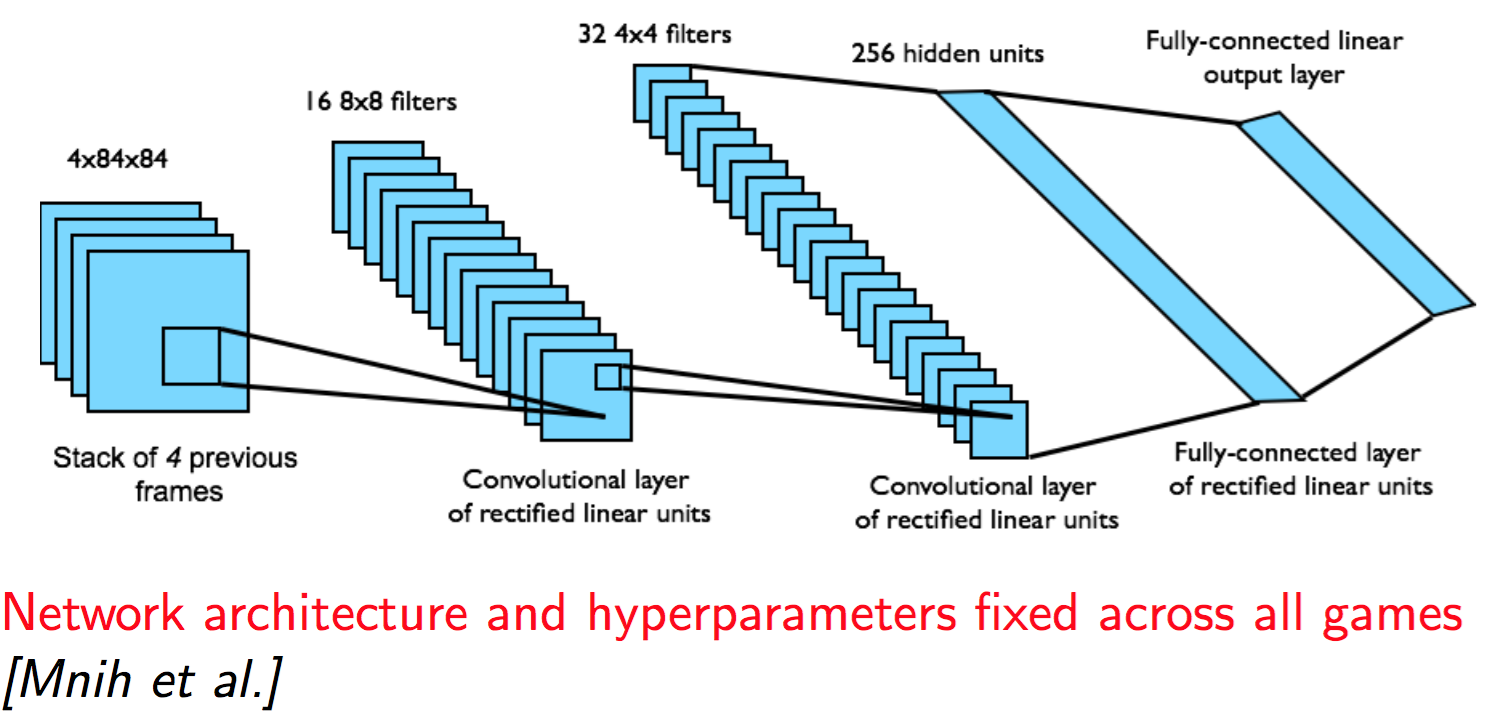Playing Atari with Deep Reinforcement Learning
Playing Atari with Deep Reinforcement Learning
Abstract
- Fist deep learning model using reinforcement learning
- Successfully learn control policies directly
- From high-dimensional sensory input
- CNN model trained on a variant of Q-learning
- Input : raw pixel, output: a value function estimating future reward
- Applied seven Atari 2600 games (no adjustment)
- Outperforms ALL previous approaches on six games
- Surpasses a human expert on three games
Problem to solve : motivation
-
Learning directly from high dimensional sensory input
-
Most successful RL relies on hand-crafted features
-
많은 사람들이 high dimensional sensory를 direct로 받고 싶었으나 이루어지지 않고 있었음. 대부분의 강화학습은 사람들이 만들어낸 feature로 진행하고 확장성이 떨어지는 단점이 있다.
Remaining challenges: cannot directly apply DL to RL
- Most DL requires hand labeled training data
- RL must learn from a scalar reward signal
- Reward signal is often sparse, noisy, and delayed
- delay between actions and resulting rewards can be thousand time steps
- Most DL assumes data samples are independent
- RL encounters sequences of highly correlated states
Solutions
- CNN with a variant Q-learning
- Experience replay
Agent and Environment
- RL에서는 a라는 action을 취하면 action의 결과로 reward r이 돌아오고 동시에 상태인 o를 볼 수 있다.
- 경험은 액션을 취함으로써 돌아오는 것들의 sequence $o_1,r_1,a_1,…,a_{t-1},o_t,r_t$
- 경험을 모은것을 state라고 한다. $s_t = f(o_1,r_1,a_1, …,a_{t-1},o_t,r_t)$
Major Components of an RL Agent
- An RL agent may include one or more of these components:
- Policy: agent’s behavior function
- 어떤 상태에 있을 때 뭘 해야되는지 알려준다.
- Deterministic policy : $a = \pi(s) 항상 일정한 정책 즉 똑같은 액션이 돌아온다 $
- Stochastic policy : $\pi(a \mid s) = P[a \mid s] $확률로 돌아온다.
- 어떤 상태에 있을 때 뭘 해야되는지 알려준다.
- Value function: how good is each state and/or action
- state s에서 어떤 행동을 하면 보상을 얼마나 받을 것인지.
- Q-Value는 어떤 행동을 했을 때 기대되는 보상
- $Q^\pi(s,a) = E[r_{t+1} + \gamma r_{t+2} + \gamma^2 r_{t+3}+ … \mid s, a] $
- Q를 배우는 과정은 Bellman equation으로 나타낼 수 있다.
- $Q^\pi (s,a) = E_{s’,a’} [r+ \gamma Q^\pi (s’,a’) \mid s, a] $
- 바로 받은 reward랑 그 다음 상태로 갔을 때 Q function에서 가장 큰 값을 더하면 된다.
- $Q^\pi (s,a) = E_{s’,a’} [r+ \gamma Q^\pi (s’,a’) \mid s, a] $
- 풀어서 봤을 때는 $Q^\ast(s,a) = \underset{\pi}\max Q^\pi(s,a) = Q^{\pi^\ast} (s,a) $
- 상태와 액션을 줬을 때 가장 optimal한 Q function을 optimal이라고 하고 *을 붙여준다.
- optimal은 Q가 가질 수 있는 최대값을 가져온다는 뜻.
- state s에서 어떤 행동을 하면 보상을 얼마나 받을 것인지.
- Model: agent’s representation of the environment
- Policy: agent’s behavior function
value based RL
- Q-networks
- Represent value function by Q-network with weights w
- $Q(s, a, w) \approx Q^* (s, a) $
- w를 가지고 있는 Q가 optimal한 Q를 닮아가도록 만드는게 목표
- Q-learning
- Optimal Q-values should obey Bellman equation
- $Q^*(s,a)= E_{s’} [r + \gamma \underset{a’}\max Q(s’,a’)^\ast \mid s,a] $
- Treat right -hand side $r + \gamma \underset{a’}\max Q(s’,a’,w) $
- Minimize MSE loss by stochastic gradient descent
- $I = (r + \gamma \underset{a’}\max Q(s’,a’,w) - Q(s,a,w))^2 $
- $ y를 r+ \gamma \underset{a’}\max Q(s’,a’,w), \hat{y}은 Q(s,a,w)로 해서 LOSS function을 구한다 $
- r은 진짜값 Q(s,a,w)는 랜덤한 값
- $I = (r + \gamma \underset{a’}\max Q(s’,a’,w) - Q(s,a,w))^2 $
- Optimal Q-values should obey Bellman equation
DQN in Atari
- End-to-end learning of values Q(s,a) from pixels s
- input state s is stack of raw pixels from last 4 frames
- Output is Q(s,a) for 18 joystick/button positions
- Reward is change in score for that step
- 최근에 나오는 네트워크에 비해서 깊지는 않다
- partially observable state 화면 하나만 보여주면 왼쪽으로 움직이는지 오른쪽으로 움직이는지 알 수 없는 것을 방지하기 위해서 화면을 4개를 동시에 사용. 액션은 화면 네번에 한번.
- state를 x(sequence)라고 생각하면 된다 화면 4개

Training and Stability
- Q는 안정적으로 converges되는 것을 보여줌.
References
- http://sanghyukchun.github.io/90/
- https://www.youtube.com/watch?v=V7_cNTfm2i8&list=PLXiK3f5MOQ760xYLb2eWbtOKOwUC-bByj&index=6

Comments